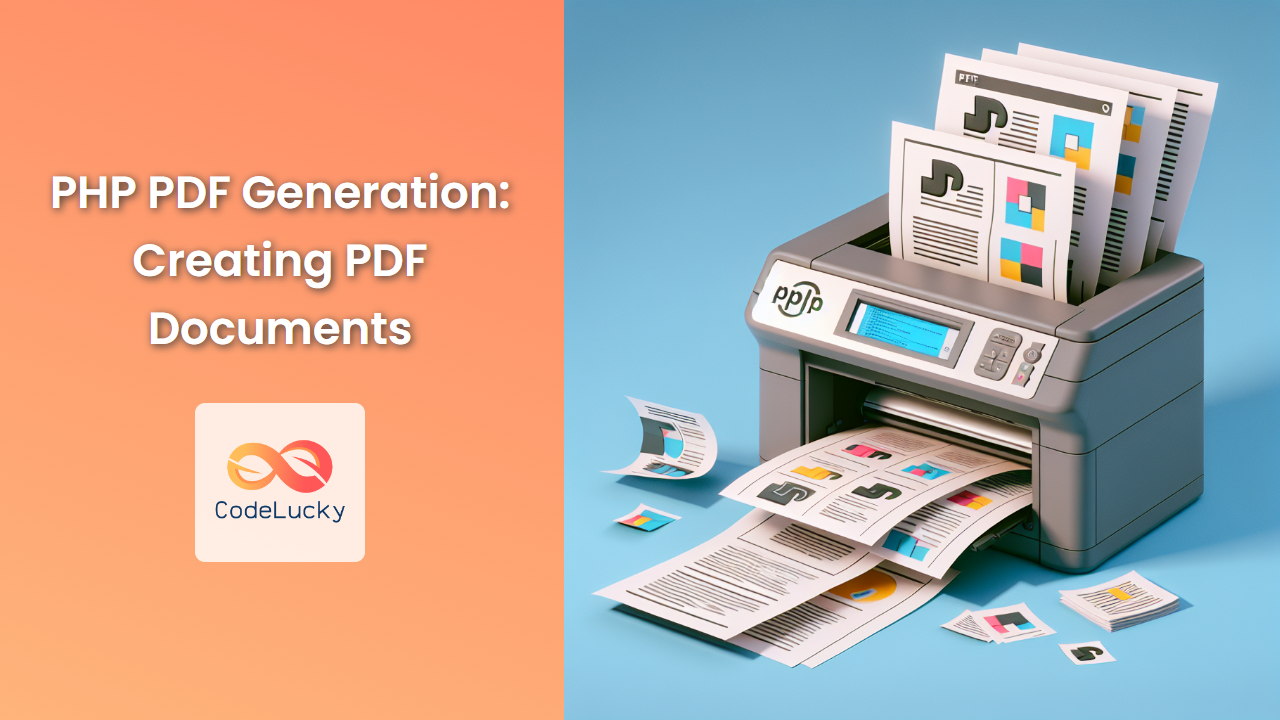In today’s digital age, the ability to generate PDF documents dynamically is a crucial skill for web developers. PHP, with its versatility and powerful libraries, offers excellent capabilities for PDF generation. This article will dive deep into the world of PHP PDF generation, exploring various methods and libraries to create professional-looking PDF documents.
Why Generate PDFs with PHP?
Before we delve into the how-to, let’s understand why PDF generation is so important:
📄 Universal Format: PDFs are readable on virtually any device or operating system.
🔒 Document Integrity: PDFs maintain their formatting regardless of where they’re viewed.
🖨️ Print-Friendly: PDFs are designed for high-quality printing.
🔗 Interactivity: Modern PDFs can include forms, links, and even multimedia elements.
Now, let’s explore how to harness PHP’s power to create these versatile documents!
Method 1: Using FPDF Library
FPDF is a popular PHP class that allows you to generate PDF files with pure PHP. It’s free, doesn’t require external libraries, and works with PHP 4 and above.
Installing FPDF
First, download FPDF from the official website and include it in your project:
require('fpdf.php');
Creating a Simple PDF
Let’s create a basic PDF with a title and some text:
<?php
require('fpdf.php');
$pdf = new FPDF();
$pdf->AddPage();
$pdf->SetFont('Arial','B',16);
$pdf->Cell(40,10,'Hello CodeLucky World!');
$pdf->Output();
?>
This script will generate a PDF with “Hello CodeLucky World!” written in bold Arial font.
Adding More Content
Let’s enhance our PDF with more content and formatting:
<?php
require('fpdf.php');
$pdf = new FPDF();
$pdf->AddPage();
// Add a title
$pdf->SetFont('Arial','B',16);
$pdf->Cell(0,10,'CodeLucky PHP PDF Tutorial',0,1,'C');
// Add some text
$pdf->SetFont('Arial','',12);
$pdf->MultiCell(0,10,'Welcome to CodeLucky\'s PHP PDF generation tutorial. Here, you\'ll learn how to create professional PDFs using PHP.');
// Add an image
$pdf->Image('codelucky_logo.png',10,50,50);
// Add a table
$pdf->SetY(100);
$pdf->SetFont('Arial','B',12);
$pdf->Cell(40,10,'Name',1);
$pdf->Cell(40,10,'Age',1);
$pdf->Cell(40,10,'City',1);
$pdf->Ln();
$pdf->SetFont('Arial','',12);
$pdf->Cell(40,10,'John Doe',1);
$pdf->Cell(40,10,'30',1);
$pdf->Cell(40,10,'New York',1);
$pdf->Output();
?>
This script creates a more complex PDF with a title, paragraph, image, and a simple table.
🎨 Pro Tip: FPDF allows you to customize colors, fonts, and even create your own headers and footers for a truly unique PDF design.
Method 2: Using TCPDF Library
TCPDF is another powerful library for PDF generation in PHP. It supports a wide range of features including UTF-8, HTML, and even barcodes.
Installing TCPDF
You can install TCPDF via Composer:
composer require tecnickcom/tcpdf
Creating a PDF with TCPDF
Let’s create a similar PDF using TCPDF:
<?php
require_once('tcpdf/tcpdf.php');
// Create new PDF document
$pdf = new TCPDF(PDF_PAGE_ORIENTATION, PDF_UNIT, PDF_PAGE_FORMAT, true, 'UTF-8', false);
// Set document information
$pdf->SetCreator('CodeLucky');
$pdf->SetAuthor('CodeLucky Author');
$pdf->SetTitle('CodeLucky PHP PDF Tutorial');
$pdf->SetSubject('TCPDF Tutorial');
$pdf->SetKeywords('TCPDF, PDF, CodeLucky, guide');
// Add a page
$pdf->AddPage();
// Set font
$pdf->SetFont('helvetica', 'B', 20);
// Add content
$pdf->Cell(0, 10, 'Welcome to CodeLucky\'s TCPDF Tutorial', 0, 1, 'C');
$pdf->Ln(10);
$pdf->SetFont('helvetica', '', 12);
$html = <<<EOD
<h2>What is TCPDF?</h2>
<p>TCPDF is a PHP library for generating PDF documents on-the-fly. It's feature-rich and supports HTML content, making it a versatile choice for PDF generation.</p>
<table border="1" cellpadding="5">
<tr>
<th><b>Feature</b></th>
<th><b>Supported</b></th>
</tr>
<tr>
<td>UTF-8</td>
<td>Yes</td>
</tr>
<tr>
<td>HTML</td>
<td>Yes</td>
</tr>
<tr>
<td>Barcodes</td>
<td>Yes</td>
</tr>
</table>
EOD;
$pdf->writeHTML($html, true, false, true, false, '');
// Close and output PDF document
$pdf->Output('codelucky_tcpdf_example.pdf', 'I');
?>
This script demonstrates TCPDF’s ability to handle HTML content, including tables, which can be incredibly useful for complex layouts.
🚀 CodeLucky Insight: TCPDF’s HTML support makes it easier to create complex layouts without having to position every element manually.
Method 3: Using Dompdf Library
Dompdf is a HTML to PDF converter. It’s particularly useful if you’re comfortable with HTML and CSS and want to leverage that knowledge for PDF generation.
Installing Dompdf
Install Dompdf via Composer:
composer require dompdf/dompdf
Creating a PDF with Dompdf
Here’s how to create a PDF using Dompdf:
<?php
require 'vendor/autoload.php';
use Dompdf\Dompdf;
// Initialize Dompdf
$dompdf = new Dompdf();
// HTML content
$html = '
<html>
<head>
<style>
body { font-family: Arial, sans-serif; }
h1 { color: #4a90e2; }
.highlight { background-color: #ffff00; }
</style>
</head>
<body>
<h1>Welcome to CodeLucky\'s Dompdf Tutorial</h1>
<p>Dompdf allows you to <span class="highlight">use HTML and CSS</span> to create PDFs.</p>
<ul>
<li>Easy to use for web developers</li>
<li>Supports most CSS properties</li>
<li>Great for report generation</li>
</ul>
</body>
</html>
';
$dompdf->loadHtml($html);
// (Optional) Setup the paper size and orientation
$dompdf->setPaper('A4', 'portrait');
// Render the HTML as PDF
$dompdf->render();
// Output the generated PDF to Browser
$dompdf->stream("codelucky_dompdf_example.pdf", array("Attachment" => false));
?>
This script demonstrates how you can use familiar HTML and CSS to style your PDF document.
💡 CodeLucky Tip: Dompdf is excellent for converting existing web pages to PDF, making it a great choice for report generation from web-based data.
Advanced PDF Techniques
Now that we’ve covered the basics, let’s explore some advanced techniques:
1. Adding Page Numbers
Using FPDF, you can add page numbers to your PDF:
<?php
require('fpdf.php');
class PDF extends FPDF
{
function Footer()
{
$this->SetY(-15);
$this->SetFont('Arial','I',8);
$this->Cell(0,10,'Page '.$this->PageNo().'/{nb}',0,0,'C');
}
}
$pdf = new PDF();
$pdf->AliasNbPages();
$pdf->AddPage();
$pdf->SetFont('Arial','',12);
for($i=1;$i<=40;$i++)
$pdf->Cell(0,10,'Printing line number '.$i,0,1);
$pdf->Output();
?>
This script creates a PDF with multiple pages, each having a footer with the current page number and total pages.
2. Creating Forms
TCPDF allows you to create fillable PDF forms:
<?php
require_once('tcpdf/tcpdf.php');
$pdf = new TCPDF(PDF_PAGE_ORIENTATION, PDF_UNIT, PDF_PAGE_FORMAT, true, 'UTF-8', false);
$pdf->AddPage();
$pdf->SetFont('helvetica', '', 12);
// Create a text field
$pdf->TextField('name', 60, 10, array('strokeColor' => array(255, 0, 0), 'lineWidth'=>1, 'borderStyle'=>'solid'), array());
// Create a combo box
$pdf->ComboBox('gender', 30, 10, array('', 'Male', 'Female', 'Other'), array('strokeColor' => array(0, 255, 0), 'lineWidth'=>1, 'borderStyle'=>'solid'));
// Create a check box
$pdf->CheckBox('agree', 5, false, array(), array(), 'OK');
$pdf->Output('codelucky_form.pdf', 'I');
?>
This script creates a PDF with a text field, a combo box, and a checkbox.
3. Adding Watermarks
You can add watermarks to your PDFs using FPDF:
<?php
require('fpdf.php');
class PDF extends FPDF
{
function Header()
{
$this->SetFont('Arial','B',50);
$this->SetTextColor(255,192,203);
$this->RotatedText(35,190,'CodeLucky Watermark',45);
}
function RotatedText($x, $y, $txt, $angle)
{
$this->Rotate($angle,$x,$y);
$this->Text($x,$y,$txt);
$this->Rotate(0);
}
}
$pdf = new PDF();
$pdf->AddPage();
$pdf->SetFont('Arial','',12);
$pdf->Cell(0,10,'This document has a watermark!',0,1);
$pdf->Output();
?>
This creates a PDF with a diagonal “CodeLucky Watermark” across the page.
Best Practices for PHP PDF Generation
To ensure your PDF generation is efficient and your documents are high-quality, follow these best practices:
- Optimize Images: Large images can significantly increase PDF file size. Compress and resize images before adding them to your PDF.
- Use Vector Graphics: When possible, use vector graphics (like SVG) instead of raster images for logos and icons. They scale better and maintain quality at any size.
- Chunk Large Documents: If you’re generating very large PDFs, consider breaking the process into chunks to avoid memory issues.
- Leverage Caching: If you’re generating the same PDF repeatedly, consider caching the output to reduce server load.
- Test Across Devices: Ensure your PDFs render correctly on different devices and PDF readers.
- Secure Sensitive Information: If your PDFs contain sensitive data, use encryption features provided by the PDF libraries.
- Accessibility: Consider making your PDFs accessible by adding proper tags and structure, especially important for government and educational institutions.
Conclusion
PHP offers robust capabilities for PDF generation, from simple documents to complex, interactive forms. Whether you choose FPDF for its simplicity, TCPDF for its feature-rich environment, or Dompdf for its HTML approach, you now have the tools to create professional PDFs tailored to your needs.
Remember, the key to mastering PDF generation is practice. Experiment with different libraries and techniques to find what works best for your specific use case. Happy coding, and may your PDFs always be pixel-perfect! 🚀📄
🔍 CodeLucky Challenge: Try creating a PDF that includes a mix of text, images, tables, and a form. Then, add a watermark and page numbers. This exercise will help solidify your understanding of PHP PDF generation techniques!



















